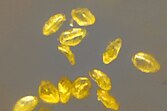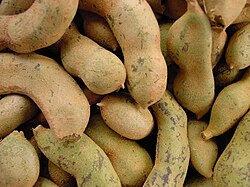Tamarind (Tamarindus indica) is a leguminous tree bearing edible fruits that is indigenous to tropical Africa. The genus Tamarindus is monotypic, meaning that it contains only this species. It belongs to family of Fabaceae.
The tamarind tree produces brown, pod-like fruits that contain a sweet, tangy pulp, which is used in cuisines around the world. The pulp is also used in traditional medicine and as a metal polish. The tree’s wood can be used for woodworking and tamarind seed oil can be extracted from the seeds. Tamarind’s tender young leaves are used in Indian and Filipino cuisine. Because tamarind has multiple uses, it is cultivated around the world in tropical and subtropical zones.
Etymology

Tamarindus leaves and fruit pod
The name derives from Arabic: تمر هندي, romanized tamar hindi, “Indian date”. Several early medieval herbalists and physicians wrote tamar indi, medieval Latin use was tamarindus, and Marco Polo wrote of tamarandi.
In Colombia, Costa Rica, Ecuador, Cuba, Dominica, Guatemala, El Salvador, Honduras, Mexico, Peru, Puerto Rico, Venezuela, Italy, Spain, and throughout the Lusosphere, it is called tamarindo. In those countries it is often used to make the beverage of the same name (or agua de tamarindo). In the Caribbean, tamarind is sometimes called tamón. In Indonesia and throughout another Malay world countries, it is called asam jawa (Javanese tamarind) or simply asam, and sukaer in Timor. While in the Philippines, it is called sampalok or sampaloc in Filipino, and sambag in Cebuano. Tamarind (Tamarindus indica) is sometimes confused with “Manila tamarind” (Pithecellobium dulce). While in the same taxonomic family Fabaceae, Manila tamarind is a different plant native to Mexico and known locally as guamúchili.
Origin
Tamarindus indica is probably indigenous to tropical Africa, but has been cultivated for so long on the Indian subcontinent that it is sometimes reported to be indigenous there. It grows wild in Africa in locales as diverse as Sudan, Cameroon, Nigeria, Kenya, Zambia, Somalia, Tanzania and Malawi. In Arabia, it is found growing wild in Oman, especially Dhofar, where it grows on the sea-facing slopes of mountains. It reached South Asia likely through human transportation and cultivation several thousand years ago. It is widely distributed throughout the tropics, from Africa to South Asia and throughout Oceania, Southeast Asia, Taiwan and China.
In the 16th century, it was introduced to Mexico and Central America, and to a lesser degree to South America, by Spanish and Portuguese colonists, to the degree that it became a staple ingredient in the region’s cuisine.
Today, India is the largest producer of tamarind. The consumption of tamarind is widespread due to its central role in the cuisines of the Indian subcontinent, Southeast Asia, and the Americas, especially Mexico.
Description

A tamarind seedling

Tamarind flower
The tamarind is a long-lived, medium-growth tree, which attains a maximum crown height of 12 to 18 metres (40 to 60 feet). The crown has an irregular, vase-shaped outline of dense foliage. The tree grows well in full sun. It prefers clay, loam, sandy, and acidic soil types, with a high resistance to drought and aerosol salt (wind-borne salt as found in coastal areas).
The evergreen leaves are alternately arranged and pinnately lobed. The leaflets are bright green, elliptic-ovular, pinnately veined, and less than 5 cm (2 in) in length. The branches droop from a single, central trunk as the tree matures, and are often pruned in agriculture to optimize tree density and ease of fruit harvest. At night, the leaflets close up.
As a tropical species, it is frost-sensitive. The pinnate leaves with opposite leaflets give a billowing effect in the wind. Tamarind timber consists of hard, dark red heartwood and softer, yellowish sapwood.


The tamarind flowers (although inconspicuously), with red and yellow elongated flowers. Flowers are 2.5 cm wide (one inch), five-petalled, borne in small racemes, and yellow with orange or red streaks. Buds are pink as the four sepals are pink and are lost when the flower blooms.

Raw tamarind fruit
Fruit
The fruit is an indehiscent legume, sometimes called a pod, 12 to 15 cm (4+1⁄2 to 6 in) in length, with a hard, brown shell.
The fruit has a fleshy, juicy, acidic pulp. It is mature when the flesh is coloured brown or reddish brown. The tamarinds of Asia have longer pods (containing six to 12 seeds), whereas African and West Indian varieties have shorter pods (containing one to six seeds). The seeds are somewhat flattened, and a glossy brown. The fruit is best described as sweet and sour in taste, and is high in tartaric acid, sugar, B vitamins, and, unusually for a fruit, calcium.
The fruit is harvested by pulling the pod from its stalk. A mature tree may be capable of producing up to 175 kg (386 lb) of fruit per year. Veneer grafting, shield (T or inverted T) budding, and air layering may be used to propagate desirable cultivars. Such trees will usually fruit within three to four years if provided optimum growing conditions.
Culinary use

